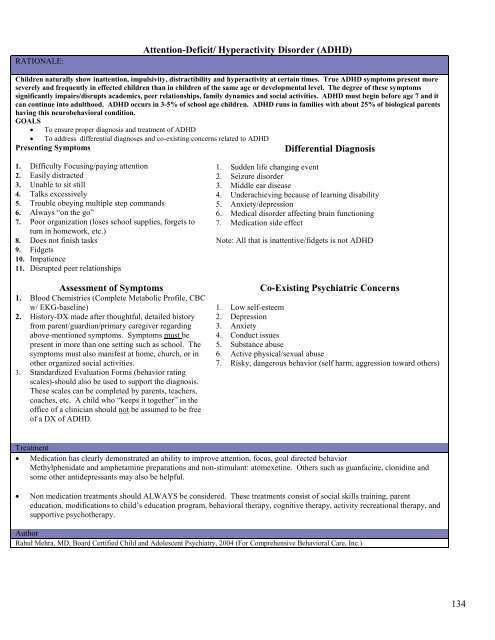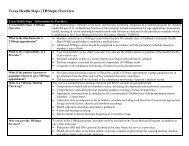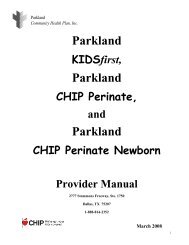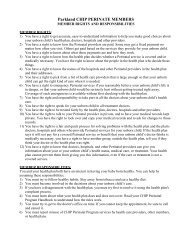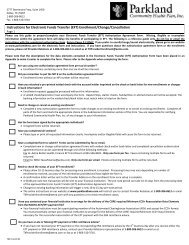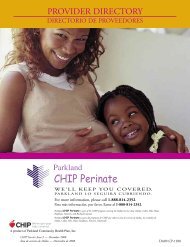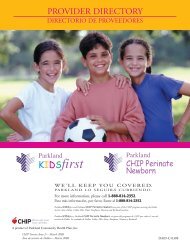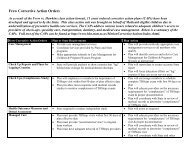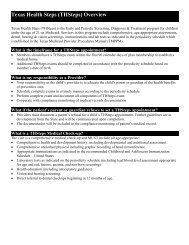PARKLAND HEALTHfirst - Parkland Community Health Plan, Inc.
PARKLAND HEALTHfirst - Parkland Community Health Plan, Inc.
PARKLAND HEALTHfirst - Parkland Community Health Plan, Inc.
Create successful ePaper yourself
Turn your PDF publications into a flip-book with our unique Google optimized e-Paper software.
RATIONALE:<br />
Attention-Deficit/ Hyperactivity Disorder (ADHD)<br />
Children naturally show inattention, impulsivity, distractibility and hyperactivity at certain times. True ADHD symptoms present more<br />
severely and frequently in effected children than in children of the same age or developmental level. The degree of these symptoms<br />
significantly impairs/disrupts academics, peer relationships, family dynamics and social activities. ADHD must begin before age 7 and it<br />
can continue into adulthood. ADHD occurs in 3-5% of school age children. ADHD runs in families with about 25% of biological parents<br />
having this neurobehavioral condition.<br />
GOALS<br />
• To ensure proper diagnosis and treatment of ADHD<br />
• To address differential diagnoses and co-existing concerns related to ADHD<br />
Presenting Symptoms<br />
Differential Diagnosis<br />
1. Difficulty Focusing/paying attention<br />
2. Easily distracted<br />
3. Unable to sit still<br />
4. Talks excessively<br />
5. Trouble obeying multiple step commands<br />
6. Always “on the go”<br />
7. Poor organization (loses school supplies, forgets to<br />
turn in homework, etc.)<br />
8. Does not finish tasks<br />
9. Fidgets<br />
10. Impatience<br />
11. Disrupted peer relationships<br />
Assessment of Symptoms<br />
1. Blood Chemistries (Complete Metabolic Profile, CBC<br />
w/ EKG-baseline)<br />
2. History-DX made after thoughtful, detailed history<br />
from parent/guardian/primary caregiver regarding<br />
above-mentioned symptoms. Symptoms must be<br />
present in more than one setting such as school. The<br />
symptoms must also manifest at home, church, or in<br />
other organized social activities.<br />
3. Standardized Evaluation Forms (behavior rating<br />
scales)-should also be used to support the diagnosis.<br />
These scales can be completed by parents, teachers,<br />
coaches, etc. A child who “keeps it together” in the<br />
office of a clinician should not be assumed to be free<br />
of a DX of ADHD.<br />
1. Sudden life changing event<br />
2. Seizure disorder<br />
3. Middle ear disease<br />
4. Underachieving because of learning disability<br />
5. Anxiety/depression<br />
6. Medical disorder affecting brain functioning<br />
7. Medication side effect<br />
Note: All that is inattentive/fidgets is not ADHD<br />
Co-Existing Psychiatric Concerns<br />
1. Low self-esteem<br />
2. Depression<br />
3. Anxiety<br />
4. Conduct issues<br />
5. Substance abuse<br />
6. Active physical/sexual abuse<br />
7. Risky, dangerous behavior (self harm, aggression toward others)<br />
Treatment<br />
• Medication has clearly demonstrated an ability to improve attention, focus, goal directed behavior<br />
Methylphenidate and amphetamine preparations and non-stimulant: atomexetine. Others such as guanfacine, clonidine and<br />
some other antidepressants may also be helpful.<br />
• Non medication treatments should ALWAYS be considered. These treatments consist of social skills training, parent<br />
education, modifications to child’s education program, behavioral therapy, cognitive therapy, activity recreational therapy, and<br />
supportive psychotherapy.<br />
Author<br />
Rahul Mehra, MD, Board Certified Child and Adolescent Psychiatry, 2004 (For Comprehensive Behavioral Care, <strong>Inc</strong>.)<br />
134


